Rāmañña Nikāya was one of the three major Buddhist orders in Sri Lanka. It was founded in 1864 when Ambagahawatte Saranankara, returned to Sri Lanka after being ordained by the Neyyadhamma Munivara Sangharaja of Ratnapunna Vihara in Burma. It was one of three Sri Lankan orthodox Buddhist monastic orders, along with Siam Nikaya and Amarapura Nikaya. On 16 August 2019, the Amarapura and Rammana Nikaya were unified as the Amarapura–Rāmañña Nikāya, making it the largest Buddhist fraternity in Sri Lanka.

The Tissamaharama Raja Maha Vihara is an ancient Buddhist temple in Tissamaharama, Southern Province of Sri Lanka. It was one of the four major Buddhist monasteries established in Sri Lanka, after the arrival of Arhant Mahinda Thera to the country. Tissamaharama monastery had been recognized as a pre-eminent Buddhist educational center of the southern Sri Lanka from the 3rd century B.C. to the 11th century A.D. The Tissamaharama Dagoba which is situated in the premises of the monastery is one of the largest stupas in Sri Lanka. The present chief incumbent of Tissamaharama Raja Maha Vihara is Ven. Devalegama Dhammasena Nayaka Thera.

Dimbulagala Raja Maha Vihara is situated 16 kilometres south east of the ancient city of Polonnaruwa, Sri Lanka. The Dimbulagala range houses a number of caves cut into the rock with Brahmi inscriptions over their drip ledges. This forest hermitage of medieval times and holy abode since time immemorial, home to some of the most valued fragments of early frescoes was called the Gunners Quoin by the British. This Buddhist monastery which was abandoned after the times of the Kingdom of Polonnaruwa was restored to the present status in the 1950s due to the efforts of Kithalagama Sri Seelalankara Thera, who was the chief incumbent of the Vihara until his death in 1995.
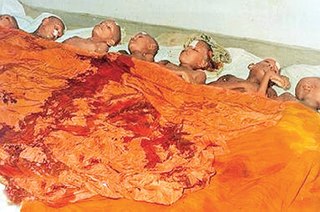
The Aranthalawa massacre was the massacre of 33 Buddhist monks, most of them young novice monks, and four civilians by cadres of the Liberation Tigers of Tamil Eelam organization on June 2, 1987, close to the village of Aranthalawa, in the Ampara District of Eastern Sri Lanka. The massacre is among the most notorious and devastating atrocities committed by the LTTE during the history of the Sri Lankan Civil War, and continues to be commemorated 35 years on.
Most Ven. Matara Sri Nanarama Maha Thera was an influential Sri Lankan meditation master, scholar and forest monk of the 20th century.
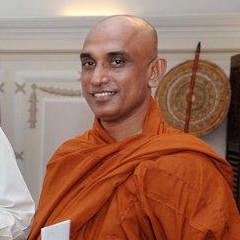
Venerable Athuraliye Rathana Thero, is a Sri Lankan Bhikkhu politician and a Member of Parliament. He is the only representative from Our Power of People's Party in the current parliament.
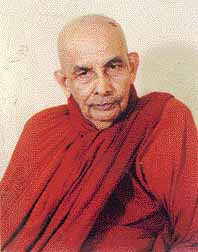
Most Venerable Madihe Pannaseeha Mahathera was an eminent Sri Lankan Buddhist monk, who was the Mahanayaka of Amarapura sect from July 13, 1969, until his death on September 9, 2003.
Śrī Kalyāṇī Yogāśrama Saṁsthā, also known as the Galduwa Forest Tradition is an independent part of the Sri Lankan Amarapura–Rāmañña Nikāya Buddhist ordination line, with their headquarters in Galduva, Kahawa, Ambalangoda. They keep a strict standard of Vinaya, recognised as the strictest standard of any major organisation in Sri Lanka. It is the largest forest sect of the Sri Lankan Sangha. Their monks are easily recognized by the palm-leaf umbrella they use and by the habit of wearing the Sanghati whenever they walk outside the monastery boundaries. Remarkably for Sri Lanka, all castes are accepted for ordination. Foreign monks, who wish to become resident at one of their monasteries, are usually expected to undergo the so-called "Dalhi-Kamma" at Galduva, a short ceremony meant to reconfirm the validity of their original Upasampada according to Galduva standard. After that they are accepted according to their normal seniority.
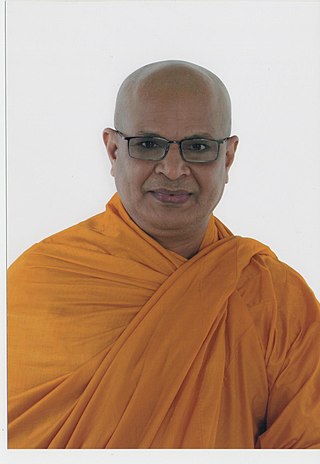
Ven Bogoda Seelawimala Nayaka Thera is the incumbent Head Priest of the London Buddhist Vihara and the current Chief Sangha Nayaka of Great Britain. He was appointed Chief Bhikkhu of the London Buddhist Vihara on 8 May 2008 following the demise of Ven Dr Medagama Vajiragnana Nayaka Thera. Ven Seelawimala Nayaka Thera hails from the Malwatte Chapter of the Siam Nikaya in Sri Lanka.
Mahanayaka theros are high-ranking Buddhist monks who oversee and regulate the Buddhist clergy in Theravada Buddhist countries. The title Maha Nayaka translates to English as 'Great Leader' and it is considered to be a very important position held by a monk in a Theravada Buddhist country. It is usually bestowed upon the senior Buddhist monks who are appointed the chief prelates of monastic fraternities known as Nikayas.
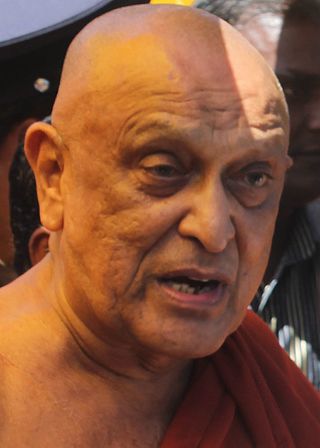
Maduluwawe Sobitha Thero was an influential Sinhalese Buddhist monk regarded for his nonviolent revolutionary leadership in Sri Lanka and the chief incumbent of the Kotte Naga Vihara. He was a prominent social-political activist, an independent thinker who endured to improve the positive and constructive aspects of Sri Lankan Politics.
Udugama Sri Buddharakkitha Thero was a Sri Lankan Buddhist monk, who was the 20th Mahanayaka of the Asgiriya chapter of Siyam Nikaya. He was presented with the religious title of Agga Maha Pandita by the government of Myanmar on March 7, 2007, in recognition of his contribution to the purification, perpetuation and propagation of Buddhism. His complete title was Most Venerable Agga Maha Panditha Udugama Sddharmakirthi Sri Dhammadassi Rathanapala Buddharakkhithabhidhana Mahanayaka Thero.
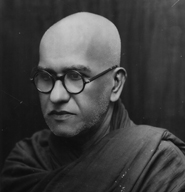
Palane Vajiragnana Thero was a Sri Lankan (Sinhala) scholar Buddhist monk, who founded the Siri Vajiraramaya temple in Bambalapitiya, Sri Lanka. He was also the Maha Nayaka (head) of Amarapura Sri Dharmarakshita sect for 37 years from August 5, 1918 until his death in 1955.

Most Venerable Galboda Gnanissara Thera was a Sri Lankan Buddhist monk who was the head priest and chief incumbent of the Gangaramaya Temple in Colombo. He was affectionately known as Podi Hamuduruwo (පොඩි හාමුදුරුවෝ), which translates to "Little Monk". In 2003, Thera was appointed by Malwatta chapter as the Sanghanayaka of the Western Province in Sri Lanka. He was also the Sanghanayaka of the Sri Lankan Buddhist temples in the United States but renounced that position later. Thera is widely recognized for various community service endeavors he undertook.
Sri Lankan Forest Monks' Tradition claims a long history. As the oldest Theravada Buddhist country in the world, several forest traditions and lineages have existed, disappeared and re-emerged circularly in Sri Lanka. The current forest traditions and lineages in Sri Lanka have been influenced by the Burmese and Thai traditions which descend from the ancient Indian and Sri Lankan traditions.
Agga Maha Pandita Kotugoda Dhammawasa Thero was an eminent Sri Lankan Buddhist monk. He was the supreme Mahanayaka of Sri Lanka Amarapura–Rāmañña Nikāya and was the chief incumbent of Sri Dharmapalaramaya, Mount Lavinia.
Asgiri Maha Viharaya is a Buddhist monastery located in Kandy, Sri Lanka. It is the headquarters of the Asgiriya chapter of Siyam Nikaya, one of the two Buddhist monasteries that holds the custodianship of sacred tooth relic of Buddha kept in Sri Dalada Maligawa, Kandy. The chief incumbent of the Asgiri Maha Viharaya is the Mahanayaka thero of Asgiri chapter of Siyam nikaya, a leading Buddhist monastic fraternity in Sri Lanka. The present chief incumbent of Asgiri Maha Viharaya is Warakagoda Sri Gnanarathana Thero. Asgiri Maha Vihara traces its origin from the Wanavasi sect of the Dimbulagala forest monastery of Polonnaruva. Currently, 565 Buddhist temples in Sri Lanka function under Asgiri Viharaya of Kandy.

The Most Venerable Datuk K. Sri Dhammaratana 拿督达摩拉达那长老 is a Sri Lankan born Malaysian Buddhist monk and the incumbent Buddhist Chief High Priest of Malaysia, since the passing of his predecessor in 2006.
Most Ven Aggamaha Panditha Napane Pemasiri Thero also spelt either as Napane Premasiri Thero or Napane Pemasiri Thero(2 January 1922/1923 – 17 November 2020) was a Sri Lankan Sinhalese Buddhist monk. He served as the 13th head of the Ramanna Nikaya since September 2012 and also served as the chief incumbent of Menikhinna Hurikaduwa Vidyasagara Privena. He was ordained on 8 July 1933.










